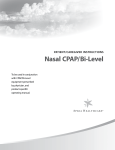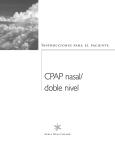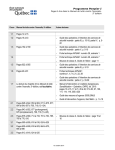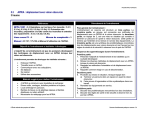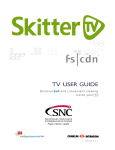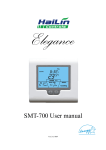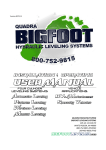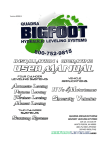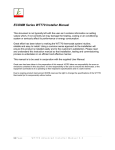Download Liquid Oxygen - Apria Healthcare
Transcript
Pat i e n t I n s t ru c t i o n s Liquid Oxygen Orientation Checklist Special instructions: i During orientation, the following information will be discussed, demonstrated and, in return, demonstrated by you. Demonstrate the following: ■ How to set-up flow rate. ■ How to read contents gauge. ■ If used, how to fill the portable unit. ■ How to approximate supply time for stationary and portable unit. ■ How to collect accumulated moisture (stationary/portable). ■ If required, how to attach and remove humidifier bottle. ■ If required, how to assemble and disassemble humidifier bottle. ■ If required, how to clean the humidifier bottle. Safety information: ■ Explain oxygen safety precautions. ■ Post “No Smoking” signs. ■ Explain approximate oxygen supply time based on prescription. ■ Explain when more oxygen should be ordered. ■ Explain oxygen delivery schedule and ordering procedure to patient/caregiver. ■ Explain importance of adequate ventilation to prevent oxygen accumulation. ■ Explain effects of cold gas and liquid on skin and eyes. ■ Explain Apria Healthcare’s recontact schedule. ■ Explain Liquid Oxygen Patient Instructions booklet. ■ Give patient/caregiver Apria Healthcare’s telephone number to call for routine and afterhours equipment problems. ■ Explain how to obtain help in a medical emergency. 02. Your Prescription . . . . . . . . . . . . . . . . . . . 03. Oxygen . . . . . . . . . . . . . . . . . . . . . . . . . . 04. Your Liquid Oxygen System . . . . . . . . . . . . 06. Operating Your Stationary Reservoir . . . . . . 07. Your Portable Unit . . . . . . . . . . . . . . . . . . 08. Operating Your Portable Unit . . . . . . . . . . . 09. Refilling Your Portable Unit . . . . . . . . . . . . 10. Maintaining Your Liquid Oxygen System . . . 11. Care of Your Humidifier Bottle. . . . . . . . . . 12. Care of Your Oxygen Tubing . . . . . . . . . . . 13. Reordering Oxygen . . . . . . . . . . . . . . . . . 14. Physical Problems . . . . . . . . . . . . . . . . . . . 15. Handwashing Technique . . . . . . . . . . . . . . . 16. Good Health Habits That Help Stop the Spread of Germs . . . . . . . . . . . . . . . . . The undersigned acknowledges that he/she has received, been instructed in, and understands the subjects shown on this page and covered in this booklet. TEAR HERE 01. Orientation Checklist . . . . . . . . . . . . . . . . 05. Your Stationary Reservoir . . . . . . . . . . . . . Liquid Oxygen Patient/Caregiver Acknowledgement: Remove and Return to Apria TEAR HERE Liquid Oxygen Patient/Caregiver Acknowledgement Patient/Caregiver Signature Please PRINT Name RES-2002 Rev. 10/09 17. Safety Precautions . . . . . . . . . . . . . . . . . . . 18. Travel Tips . . . . . . . . . . . . . . . . . . . . . . . . 19. Troubleshooting . . . . . . . . . . . . . . . . . . . . 20. Feedback on Our Services . . . . . . . . . . . . . Date Apria Representative Please PRINT Name Date Table of Contents i Your Prescription . . . . . . . . . . . . . . . . . . . . . . . 2 Oxygen . . . . . . . . . . . . . . . . . . . . . . . . . . . . . . 3 Your Liquid Oxygen System . . . . . . . . . . . . . . . 4 Your Stationary Reservoir . . . . . . . . . . . . . . . . . 5 Operating Your Stationary Reservoir. . . . . . . . . . 6 Your Portable Unit . . . . . . . . . . . . . . . . . . . . . . 9 Operating Your Portable Unit . . . . . . . . . . . . . 10 Refilling Your Portable Unit . . . . . . . . . . . . . . 11 Maintaining Your Liquid Oxygen System . . . . . 15 Care of Your Humidifier Bottle . . . . . . . . . . . . 16 Care of Your Oxygen Tubing. . . . . . . . . . . . . . 18 Reordering Oxygen. . . . . . . . . . . . . . . . . . . . 19 Physical Problems . . . . . . . . . . . . . . . . . . . . . 20 Handwashing Technique . . . . . . . . . . . . . . . . . 21 Orientation Checklist . . . . . . . . . . . . . . . . . . . . . Good Health Habits That Help Stop the Spread of Germs . . . . . . . . . . . . . . . . . . 22 Safety Precautions . . . . . . . . . . . . . . . . . . . . . 23 Travel Tips . . . . . . . . . . . . . . . . . . . . . . . . . . 26 Troubleshooting . . . . . . . . . . . . . . . . . . . . . . 28 Feedback on Our Services . . . . . . . . . . . . . . . 30 ©1997, 2001, 2003-2005, 2007-2009 Apria Healthcare, Inc. Apria Healthcare with its accompanying logo is a registered trademark of Apria Healthcare Group Inc. Your Prescription Your physician has prescribed your oxygen to be used in the following manner: ____ liters per minute during normal activity. ____ liters per minute during sleep. ____ liters per minute when exercising. ____ liters per minute continuously. Please note that the information provided here is meant to supplement, not replace, any special directions provided by your physician. Equipment and Accessories Part Number 2 Oxygen is a prescribed drug. Never increase or decrease your oxygen flow rate without the specific approval of your physician. If your physician changes your oxygen flow rate or hours of use, notify Apria Healthcare immediately. Description Oxygen All people need oxygen in order to live. Oxygen is a gas that we can’t see, taste, or smell, yet is always there in the air which surrounds us. The amount of oxygen in the air is always 21%. Oxygen is inhaled into our lungs and is then transported through the blood to all parts of the body. Oxygen helps convert food to heat and energy. This process is called metabolism. When the respiratory system is working properly, oxygen is inhaled and transported to the cells with ease. Carbon dioxide, a by-product of metabolism, is then returned to the lungs and exhaled. Using Supplemental Oxygen The 21% concentration of oxygen in the air around us is enough for people with normally functioning lungs and heart. However, a person with lung or heart problems may often benefit from breathing air which has a higher concentration of oxygen in it. The respiratory system When the body does not get enough oxygen, a person may experience difficulty in breathing, fatigue, loss of memory, headaches and/or confusion. Using supplemental oxygen may help provide relief from these symptoms. 3 Your Liquid Oxygen System When oxygen is cooled to a very low temperature (around 300 degrees below zero Fahrenheit), it becomes a liquid. In the liquid form, large amounts of oxygen can be stored in a container at quite low pressure. This provides not only a large storage capacity, but also allows for filling and refilling of a smaller unit from the large unit. To remain in the liquid form, the oxygen must continue to be kept very cold. Therefore, the units in which the liquid oxygen is stored are insulated canisters similar to large Thermos® bottles. As the liquid oxygen leaves the container, it warms up to room temperature and becomes a gas again. A liquid oxygen system usually includes two units: a stationary reservoir and a portable unit. 4 Your Stationary Reservoir Flow Selector Contents Indicator Filling Connector Nipple A typical stationary reservoir Flow Selector Contents Indicator Filling Connector The liquid oxygen stationary reservoir is a large unit. The stationary reservoir can store over 75 pounds of liquid oxygen. For most patients, this will last from four to eight days. Stationary reservoirs are available in different sizes and models. However, all models have the same basic parts: a contents indicator that shows the amount of oxygen in the unit, a flow selector that regulates the amount of oxygen you receive, a filling connector that allows the portable unit to be filled, and, if recommended by your physician, a humidifier bottle. The oxygen is delivered to you through a nasal cannula or face mask. The tubing on the cannula or mask is attached to the outlet nipple or, if recommended by your physician, the humidifier outlet bottle nipple. Sometimes, an extra length of tubing may be attached. This will allow you to move about at a farther distance from your stationary reservoir. Nipple Humidifier Bottle (if recommended) Detail of stationary reservoir with humidifier bottle 5 Operating Your Stationary Reservoir The following step-by-step instructions will help you operate your stationary reservoir. If your physician has specified a humidifier with your stationary reservoir, go to step 2. Step 1: Attach a nipple valve to the reservoir outlet tube and attach the oxygen tubing to the nipple outlet. Step 2: If recommended, attach a filled humidifier bottle. • Center the threaded cap on the humidifier bottle under the threaded outlet tube on the reservoir. • Turn the cap on the humidifier bottle until it is tightly screwed onto the outlet tube. • Attach oxygen tubing to the nipple outlet on the humidifier bottle lid. Note: Humidifier bottles are generally recommended only for patients using flow rates greater than four liters per minute. Step 3: Adjust the oxygen flow rate by turning the liter control knob until the flow is at the prescribed number. Rotary Flow Control Turn the dial until the prescribed liter number appears and the switch clicks into position. Adjusting oxygen flow rate using a rotary flow control dial 6 Step 4: Fit the nasal cannula or the oxygen mask to your face so it is comfortable. Follow the instructions below for either the nasal cannula or oxygen mask, depending on which one your physician has prescribed. Operating Your Stationary Reservoir (continued) Nasal Cannula • Insert the two prongs of the cannula into your nostrils. Make sure the prongs face upward and curve into your nostrils. • Slide the tubing over and behind each ear. Adjusting nasal cannula • Adjust the tubing to fit comfortably under your chin by sliding the adjuster upward. Be careful not to adjust it too tightly. Note: Do not use an oxygen mask if your physician prescribed a nasal cannula. Oxygen Mask • Place the oxygen mask over your mouth and nose. • Slide the loose elastic strap over your head and position it above your ears. Adjusting oxygen mask • Pull the end of the elastic on each side of the mask until the mask fits comfortably. Pinch the metal nose strap to fit snugly around your nose. This will prevent oxygen from blowing into your eyes. Note: Oxygen masks must only be used with liter flow rates of five liters per minute or greater. Step 5: You should use your oxygen for the number of hours your physician has prescribed. When you have finished using your oxygen, you should: • Remove the nasal cannula or the oxygen mask. • Turn the liter control knob off. You should also check the amount of oxygen remaining in your stationary reservoir daily so you will know when to order a refill. 7 Operating Your Stationary Reservoir (continued) Needle Gauge E The position of the needle will tell you approximately how full your reservoir is. You may have to depress a push button on the top of the unit to light up the meter face and cause the needle to register. F Bar-Type Gauge A typical needle gauge Depress the red button on the top of the reservoir. Read across the top of the lighted bar to the scale at the right. –F LOW BATT 3 – /4 1 – /2 1 – /4 Weight Scale Base The position of the metal pointer on the scale under your reservoir will tell you approximately how full your reservoir is. –E A typical bar-type gauge Contents Guide: Stationary Unit Your oxygen flow is measured in liters per minute (LPM). Average oxygen usage time is based on continuous Stationary Reservoir flow rate. These figures are Approximate Time in Hours approximate and are to be Puritan- Puritan- Puritanused only as a general guide. Bennett Bennett Bennett Caire Caire Liter Companion Companion Companion Liberator Liberator Individual usage time may vary. Flow 8 21 31 41 30 45 1 288 425 562 333 483 2 144 212 281 166 242 3 96 141 187 111 161 4 72 106 140 83 121 5 57 85 112 67 97 If you are at all confused concerning when to order an oxygen refill, please contact your Apria Healthcare representative. Your Portable Unit Flow Control Knob Oxygen Contents Gauge LO W –E –1 / 4 –1 2/ –F Filling Connector –3 / 4 Oxygen Outlet The portable liquid oxygen unit is a small unit which is intended to be used during activities outside the home. Depending on the size, the portable unit weighs seven to ten pounds when full and will provide four to eight hours of continuous oxygen for most patients. Actual times will vary depending on your liter flow. The portable unit can be simply and conveniently filled from the stationary reservoir. The unit is carried by means of a shoulder strap or lightweight wheeled cart. Portable liquid units are available in different sizes and models but all have the same basic parts: a flow control knob which provides the desired flow of oxygen, an oxygen contents gauge which tells you approximately how much oxygen remains in the unit, a filling connector which allows you to attach the portable unit to the stationary reservoir for refilling, an oxygen outlet to which your oxygen tubing attaches, and a shoulder strap which allows you to comfortably carry your unit. Condensation Pad Shoulder Strap A typical portable liquid oxygen unit Some portable units have a condensation pad on the bottom of the unit. If the pad gets wet, remove the plastic cover and pad and allow the pad to air dry before using the portable unit. 9 Operating Your Portable Unit E F The following step-by-step instructions will help you operate your portable liquid oxygen unit. Step 1: Check the amount of liquid oxygen in your unit. When the portable unit is not in use, the liquid oxygen it contains will evaporate within 24 hours. Be sure your unit has enough oxygen in it to accommodate your expected usage time. If you are unsure, contact your Apria Healthcare representative. Needle Gauge A typical needle gauge The position of the needle will tell you approximately how full your unit is.You may have to depress a push button to light up the meter face and cause the needle to register. Bar-Type Gauge –F LOW BATT 3 – /4 1 – /2 1 – /4 –E A typical bar-type gauge Depress the red push button on top of the unit. Read across the top of the lighted bar to the scale at the right. Step 2: Attach the oxygen tubing to the oxygen outlet on the side of the unit. Step 3: Adjust the oxygen flow by turning the knob until the prescribed liter number appears and the switch clicks into position. Be sure not to set the control knob between number positions or no oxygen will flow. Step 4: Always keep your portable unit in an upright position. If the unit is accidentally tipped over, you may hear hissing and see oxygen vapor escaping. Place the unit upright immediately. 10 Refilling Your Portable Unit To refill your portable liquid oxygen unit from the stationary reservoir, follow the steps below. Step 1: Wipe the filling connectors on both the portable unit and the stationary reservoir with a clean lint-free cloth. These fittings must be dry. Moisture could cause the units to freeze together. Step 2: Turn the flow control knob on the portable unit off. Step 3: Attach the portable unit to the stationary reservoir at the filling connectors. Some units refill from the side of the reservoir, while others refill at the top of the reservoir. Follow the instructions on either page 12 or 13, depending on the type of unit you use. Attaching portable units to stationary reservoirs 11 Refilling Your Portable Unit (continued) Side Mount Refill Tilt the portable unit counter-clockwise to a 45 degree angle. Insert the portable unit connector into the reservoir connector. Tilt the portable unit and insert the connector Rotate the portable unit clockwise to an upright position 12 Rotate the portable unit clockwise to an upright position until the pin locks into place.You should not have to force it to rotate. Continue to step 4 on page 13. Refilling Your Portable Unit (continued) Top Mount Refill Center the portable unit connector over the reservoir connector. Center the portable unit connector Lower the portable unit and rotate Lower the unit into the shaped recess or onto the connector. Once the unit is resting on the connector, rotate clockwise until the pin locks into place and firm resistance is felt. Step 4: Open the fill valve by either depressing the fill button or using a key (depending on your specific model). This valve is found either on the reservoir or on the portable unit (see page 14 for illustration). • This will start the filling process. • As the unit is filling, you will hear a hissing noise. • When the unit is full, the hissing noise will change and you may see a small cloud of white vapor at the connection. • Always watch the units carefully while filling. Fill time is approximately two minutes. Step 5: When the unit is full, slowly close the fill valve. Opening the fill valve on the reservoir Step 6: Disengage the portable unit from the stationary reservoir. • If the portable unit does not separate easily, do not force it. The units may be frozen together.Wait until the units warm up and they will separate easily. • DO NOT TOUCH any frosted parts of the connectors. Liquid oxygen can cause frostbite to the skin. Step 7: Reattach the oxygen tubing to the oxygen outlet on the portable unit.Your unit is now ready for use. 13 Refilling Your Portable Unit (continued) Please Note • Liquid oxygen will slowly evaporate from a portable unit. To avoid excessive waste, fill the portable unit just before use. • If, when separating the portable unit from the stationary unit, the liquid oxygen continues to flow out of the stationary unit, do not attempt to reconnect the portable unit. Stand away from the unit and call Apria Healthcare. • Always store the portable unit in a wellventilated area. Contents Guide: Portable Unit Opening the fill valve on the portable unit Your oxygen flow is measured in liters per minute (LPM). Average oxygen usage time is based on continuous flow rate. These figures are approximate and are to be used only as a general guide. Individual usage time may vary. Portable Reservoir Approximate Time in Hours (h) and Minutes (m) PuritanPuritanPuritanBennett Bennett Bennett Liter Companion Companion Companion Flow 500 550 1000 Caire Stroller 1 9h 13h 30m 15h 30m 11h 45m 2 4h 40m 6h 30m 8h 30m 6h 20m 3 3h 6h 30m 5h 48m 4h 4 2h 12m 5h 6m 4h 18m 3h 15m 5 1h 48m 4h 12m 3h 24m 2h 40m 14 Since this guide is an approximation, always add an extra 30 minutes when estimating your portable oxygen needs. Maintaining Your Liquid Oxygen System Liquid oxygen units are durable pieces of equipment and will continue to operate efficiently with proper maintenance. As necessary, you should wipe the outside of your units with a clean damp cloth. Never use wax, cleaning sprays or furniture polish. Many of these products are flammable. You should never open either of your own units or attempt any repairs on them. Never use grease, oil or other lubricants on your units. Many lubricants are volatile and could cause a safety hazard. Never use wax, cleaning sprays or furniture polish on liquid oxygen units Should you have any problems with your liquid oxygen system at any time, call Apria Healthcare immediately. We are available 24 hours a day, seven days a week for emergencies. 15 Care of Your Humidifier Bottle Cleaning and disinfection of respiratory therapy equipment in the home is of major importance. To prevent equipment contamination, a simple but effective cleaning procedure must be carried out on a routine basis. Do all cleaning and disinfecting in a clean environment. Avoid doing it after vacuuming, under an open window, or in dusty, dirty, smoky areas. If you are using a humidifier bottle with your oxygen system, you will need to check the water level in the jar frequently. When the water runs low or the bubbling stops, you will need to refill the jar. Always use your back up oxygen system while refilling and cleaning your humidifier bottle. Refilling the Humidifier Bottle Rinse bottle under a strong stream of warm tap water Step 1: Wash your hands as instructed on page 21. Step 2: Turn your oxygen off. Step 3: Unscrew the jar from the humidifier bottle lid. Step 4: Discard any water remaining in the jar. Step 5: Rinse bottle under a strong stream of warm tap water. Shake off the excess water. Refill the jar with distilled water 16 Step 6: Refill the jar with distilled water to the fill line. Do not overfill the bottle. Too much water in the bottle will cause water to collect in your oxygen tubing. Care of Your Humidifier Bottle (continued) Step 7: Screw the bottle back on the humidifier bottle lid until it is tight. Be certain the jar is screwed on straight. Cross-threading will cause oxygen to escape out the top of the jar. Twice Weekly Cleaning and Disinfection It is very important to clean your humidifier bottle to prevent infection. The following procedure should be done every three days: Step 1: Wash your hands as instructed on page 21. Step 2: Turn the oxygen off. Step 3: Remove the humidifier bottle. Step 4: Wash the entire humidifier bottle in a solution of liquid detergent and warm water. Wash the humidifier bottle every 3 days Step 5: Rinse the bottle thoroughly. Shake off the excess water. Step 6: Mix one part white vinegar and one part water. Step 7: Soak humidifier bottle for 30 minutes in vinegar solution. Step 8: Rinse bottle in warm tap water. Step 9: Allow the bottle to air dry. Step 10: Discard vinegar solution. Step 11: Replace your humidifier bottle as instructed above. 17 Care of Your Oxygen Tubing Minimal care is required of your oxygen tubing and nasal cannula or oxygen mask.You should discard and replace your nasal cannula or oxygen mask every two weeks. Discard and replace your tubing every 90 days. Do not use alcohol or oil-based products on or near your cannula. Occasionally, if you are using a humidifier bottle, moisture may accumulate inside your oxygen tubing. If this becomes uncomfortable, you should try the following procedure. Always use your backup oxygen system when clearing moisture from your oxygen tubing. Oxygen Tubing Nasal Cannula Clearing Moisture from Your Oxygen Tubing Step 1: Remove the humidifier bottle from the outlet tube on the liquid unit. Step 2: Attach a nipple adapter to the outlet tube. Step 3: Remove the oxygen tubing from the humidifier bottle and attach it to the nipple adapter. Step 4: Allow the oxygen to run directly through the tubing. Within a few minutes, the tubing will be dry. Step 5: When the tubing is dry, disconnect it, remove the nipple adapter, reconnect the humidifier bottle to the liquid oxygen unit and reattach the oxygen tubing to the humidifier bottle. Step 6: Recheck the liter flow gauge to make sure the oxygen is flowing at the prescribed level. 18 Reordering Oxygen Always be aware of the amount of oxygen remaining in your stationary reservoir. You will most likely be on an automatic redelivery schedule, but always knowing how much oxygen you have will prevent any worry of running out before your next supply is delivered. If you are not on an automatic delivery schedule, reorder oxygen one to two days before your stationary reservoir has been calculated to run out. This will allow your Apria Healthcare location to schedule your delivery without causing you to worry. Consult the table on page 8 for guidelines on the approximate time for use of your unit. 19 Physical Problems If you experience any of the following problems, call your physician. • Fever or chills • Increased wheezing • Increased mucus production • Mucus becomes thicker • Change in mucus color • Headaches • Loss of appetite • Increased shortness of breath • Chest pain • Increased cough • Swelling in your ankles or around your eyes • Weight gain overnight • Feeling dizzy or sleepy • Any change in physical sensation after taking a new medication If you are having trouble with your equipment call Apria Healthcare. If you experience any physical change, call your physician. If you experience severe physical problems, call your local emergency services. 20 Handwashing Technique Hands must be clean prior to handling supplies and solutions. Wash hands before beginning any procedure. Step 1: Wet hands thoroughly with warm water. Step 2: Use antibacterial soap. Step 3: Wash hands for one to two minutes using a rotary motion and friction. Wash: • Back and palm of each hand • Between all fingers Step 4: Rinse hands under running water. Step 5: Dry on clean towel or with paper towel. Wash hands for 1–2 minutes 21 Good Health Habits That Help Stop the Spread of Germs Cover Your Cough Cover your mouth and nose when you cough or sneeze. Put your used tissue in a waste basket. You may be asked to put on a mask to protect others. Clean Your Hands After Coughing or Sneezing Wash your hands with soap and warm water for 20 seconds OR clean with alcohol-based hand sanitizer. Protect others from germs that may be spread when you cough or sneeze Remember to clean your hands well if you are coughing or sneezing 22 Safety Precautions Oxygen will not explode or burn. Oxygen will cause anything that is burning to burn hotter and faster. By using the following safety rules, you will create a very safe environment when you use your oxygen. Heat Keep the liquid oxygen unit and oxygen tubing away from any source of heat. Keep the liquid oxygen units and oxygen tubing away from open flames, stoves, space heaters, large windows or any source of heat. Grease Never grease or oil oxygen equipment Never grease or oil oxygen equipment. Keep liquid units away from all flammable materials such as oil, grease, Vaseline®, hair lubricants, face and hand lotions, and aerosol sprays. Smoking Do not permit smoking in the same room as you and/or your oxygen equipment. Place “No Smoking” signs on the front and back door of your residence and also at the entryway to the room where you will be using your oxygen. Do not permit smoking in the same room as oxygen equipment It is possible for you to be in a large room such as a restaurant where smoking is permitted as long as no lighted smoking materials are within five feet. Ask to sit in the non-smoking section of the restaurant. 23 Safety Precautions (continued) Cooking It is best to cook using only a microwave oven. Cooking on a gas stove is not recommended. Storage Do not store your oxygen equipment in a small storage area. Do not place oxygen equipment in a storage area such as a closet or car trunk. Any venting oxygen could create a fire hazard. Oil-Based Toiletries and Small Appliances Never use oil-based face creams, a hair dryer or an electric razor while using oxygen. It is possible in certain conditions that the combination of oxygen, oil-based face creams, and a spark from an electric appliance could ignite and cause burns to your face. Always use water-based cosmetics or creams. Frost Burns Never touch the frosted connectors on the liquid units. Liquid oxygen is chilled to around 300 degrees below zero Fahrenheit. If you touch one of the frosted parts on your unit, it is possible that you will receive a skin burn. If contact occurs, generously flush with cold water and call your physician. 24 Safety Precautions (continued) Moving Your System Never move the stationary unit without consulting with your Apria Healthcare location. Spillage Keep the liquid unit upright at all times. Keep the liquid unit upright at all times If your liquid unit falls over on its side, it is possible for a stream of liquid oxygen to spill out of the reservoir. To avoid spillage, keep the stationary unit upright at all times. If a spill occurs, open doors and windows to ventilate the area and call Apria Healthcare immediately. Make Sure Your Home Address Is Visible Make sure your home address can be easily seen from the street during both day and night. If you are expecting a night delivery or visit, turn on the porch light. Check to see that your address numbers are easy to spot and read from the street. This will allow all Apria Healthcare and emergency services to locate your residence easily. Follow Emergency and Natural Disaster Instructions In the event of an emergency or natural disaster, follow the radio or television instructions of your local authorities. 25 Travel Tips Early planning and careful preparation are the keys to an enjoyable trip. The following tips should help you plan and prepare for any trip. • Contact your physician to make sure your proposed trip is medically safe and to obtain additional copies of your prescription. • Contact Apria Healthcare for assistance with getting oxygen refills along your driving route or at your final destination. • Have cash available to pay for oxygen refills or equipment. Visit us at www.Apria.com to request a free Apria Great Escapes™ Patient Travel Program Kit. Or, call your local Apria branch. If traveling by car or recreational vehicle: • Remind passengers not to smoke in the vehicle in which you are traveling. • Securely fasten tanks. • Keep one window partially open to provide fresh air circulation. • Do not store oxygen in the trunk of your car. • Do not store oxygen in an area where the temperature will reach 120 degrees Fahrenheit. • Keep liquid oxygen in an upright position. • When traveling in, or occupying a recreational vehicle, do not store oxygen near gas or open flame. • Stay at least five feet away from all open flames, such as camp stoves, lanterns, heaters, etc. 26 Travel Tips (continued) • Never refill your portable unit inside your car or recreational vehicle. If traveling by bus, train or ship: • Contact the reservation office for specific information about the use of oxygen and special accommodations. • Most companies require at least two weeks notice if you are going to be using oxygen on your trip. If traveling by airplane: • Most airlines require at least four weeks notice if you are going to be using oxygen on your trip. • Ask your physician what flow rate to use during your flight. • Request a direct flight, if one is available. • Apria Healthcare offers its Great Escapes™ program to assist with your travel arrangements. Contact your Apria branch at least six weeks prior to your travel date for more information. • Most airlines allow patients to bring portable oxygen concentrators on board. As part of Apria Great Escapes travel program, Apria can provide most patients with a portable oxygen concentrator that is allowed on most airlines. • Before you depart on a plane, ensure that arrangements have been made for your oxygen at your final destination. For further information, please contact your local Apria Healthcare location to assist with your travel arrangements. 27 Troubleshooting Trouble No oxygen coming from cannula or mask Portable unit cannot be removed from stationary system 28 Probable Cause Remedy Decreased awareness of oxygen flow Place cannula prongs in a clean glass of water. If you observe bubbles coming from your cannula, your unit is working correctly. Loose connections Check each connection from the unit to the cannula to ensure a tight fit. If you are using a humidifier bottle, check to see that it is screwed on tight. Flow control knob is not pointing directly to setting Adjust flow knob to point directly to prescribed setting. Unit is empty Call Apria Healthcare for immediate delivery. Dirty or faulty cannula or mask Remove cannula or mask and check tubing for kinks or obstructions. Replace with new cannula or mask if needed. Stationary unit obstructed flow Fill portable and call Apria Healthcare location. Units are frozen together Wait 15 to 30 minutes for connections to thaw. Troubleshooting Trouble Probable Cause (continued) Remedy Portable unit does not last as long as usual Not fully filled Review filling procedure. If problem persists call Apria Healthcare. White vapor spewing out of connector after uncoupling Fill valve stuck open Immediately reconnect portable to stationary while being careful not to come into contact with the vapor. Wait 15 to 30 minutes for ice to thaw. Remove portable. All other problems or questions about equipment Call your Apria Healthcare location. 29 Feedback on Our Services Apria Healthcare is among America’s most experienced and respected home respiratory care providers, and our patient satisfaction scores are consistently high. It is possible, however, that you may have a concern and we welcome feedback. To voice a concern, you should take these steps: 1. Call your local Apria branch and ask to speak to the branch manager. OR 2. Contact us by e-mail at: [email protected] OR 3. Visit our Web site at www.Apria.com Satisfaction Survey Process Our goal is to ensure your satisfaction.You will likely receive an Apria patient satisfaction questionnaire and we hope that you will take a few minutes to fill it out and return it to us. The postage is prepaid by Apria Healthcare. 30 Education News Articles Services www.Apria.com RES-2002 R e v. 1 0 / 0 9




































